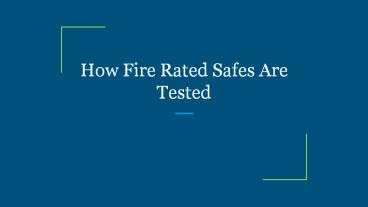How Fire Rated Safes Are Tested - PowerPoint PPT Presentation
Title:
How Fire Rated Safes Are Tested
Description:
Terrifying in the level of destruction they can cause, fires cost home and business owners billions of dollars in property damages every year. In a frightening statistic reported by global, non-profit organization The National Fire Protection Agency (NFPA), a home structure fire takes place as often as every 85 seconds. – PowerPoint PPT presentation
Number of Views:19
Title: How Fire Rated Safes Are Tested
1
How Fire Rated Safes Are Tested
2
- Terrifying in the level of destruction they can
cause, fires cost home and business owners
billions of dollars in property damages every
year. In a frightening statistic reported by
global, non-profit organization The National Fire
Protection Agency (NFPA), a home structure fire
takes place as often as every 85 seconds. - With this in mind, its little wonder that
theres a continuing need for fire rated safes,
but how do you know if the safe youre about to
purchase (or have already purchased), will give
you adequate protection against the ravages of a
house fire? While a conversation with anyone
specializing in the manufacture or sale of safes,
will answer all of your fire rated safe questions
for you, it can be helpful to understand a little
bit yourself, before buying one
3
- What to look for in a fire rated safe
- Offering the ultimate in fire protection, a safe
constructed with inner and outer steel plates
that enclose a poured fire insulating material to
create a seamless fire barrier, will have been
tested by Underwriters Laboratories (UL rating)
or Intertek (ETL). - Next in terms of the level of protection they
offer, are fire safes built with between 2 and 4
layers of gypsum board that are positioned
throughout the interior body and door. These are
typically tested and verified by Intertek (ETL).
4
- Offering adequate protection, fire safes that are
built with 1 or 2 layers of gypsum board
positioned throughout the interior body and door,
have a manufacturers independent fire rating. - Fire labels explained
- Safes with a UL Label/Class 350 degrees
Fahrenheit- one hour and Class 350 degrees
Fahrenheit-two hour, are designed to maintain a
temperature less than 350 degrees Fahrenheit
inside the safe, when exposed to fire for a
period of one hour at 1700 degrees Fahrenheit or
for a period of two hours at 1850 degrees
Fahrenheit.
5
- These safes must have successfully undergone all
other necessary requirements for the Fire
Endurance Test, Explosion Hazard Test and the
Fire/Impact Test. See below for more details
about all three of these tests - Fire endurance test
- The safe is locked and exposed to what is
described as a uniformly distributed fire, with
heat sensors and paper placed inside. Controlled
to reach a maximum temperature of 1700F for a
period of one hour, or 1850F for two hours, the
furnace is then allowed to cool without being
opened. Recorded throughout the test and during
the cooling period, a definite drop in
temperature must be illustrated never exceeding
350F.
6
- When the safe has cooled, its opened and all of
the locking mechanisms and parts fastenings are
examined, along with the interior, which is
checked for any evidence of undue heat
transmission. - Explosion hazard test
- Locked and placed inside a furnacepreheated to
2000F, the safe is kept there for 30 minutes,
and in the event of no explosion, is left to cool
without opening the furnace doors. When cool, the
safe is examined using the same process as the
Fire Endurance Test.
7
- Fire Impact Test
- Once the explosion hazard test is finished, the
safe is taken out of the furnace and within two
minutes, is dropped from a height of 30 inches
onto a heavy concrete base. The safe is then
examined for signs of deformation, parts
rupturing, and damaged insulation. When cool, the
safe is inverted and reheated to 1550F for 30
minutes. - Once cool again, the safe is examined, just as
with the previous two tests.
8
- For more detailed guidance on purchasing a fire
rated safe for your home or business, reach out
to a local safe specialist, who can help you get
the best deals, for the best safes. - BigBearSafe designs, manufactures and distributes
a large variety of high security safes, fireproof
home safe, vault doors and other physical
security equipment since 1999. With a team of
highly skilled workers and engineers our primary
goal is not only to meet our customers
expectations, but to exceed them through superior
quality and security. If you are looking for fire
safe box in Huntington Beach, visit
BigBearSafe.com.

